 Service hotline:86-029-89186965
Service hotline:86-029-89186965  ENGLISH
ENGLISH  CHINESE
CHINESE



































1. Check the input voltage: Use a multimeter to measure the input voltage and ensure that it is within the range.
2. Check the output voltage: Measure the output voltage with a multimeter or oscilloscope to ensure that it is within the range.
3. Check the output current: Measure the output current with a multimeter or ammeter to make sure it is within the range.
4. Check thermal protection: Check whether the power module has the thermal protection function. If yes, check whether that it works properly.
5. Checking overload protection: Check whether the power module has the overload protection function. If yes, check whether that it works properly.
6. Check short circuit protection: Check whether the power module has the short circuit protection function. If yes, check whether that it works properly.
7. Check the capacitor: Check whether the power module capacitor is working properly, if it's short circuit or open, it needs to be replaced.
8. Check the radiator: Check whether the radiator of the power module is working properly. If it overheats, replace it or clean it.
9. Check other components: Check whether other components of the power module is working properly, such as diodes and transistors, etc.
10. Fault analysis and repair: According to the above inspection results, analyze the cause of the fault and repair.
——
——
——
——
——
——
©2019 XI'AN W&H-GAMAY TECHNOLOGY CO., LTD ALL RIGHTS RESERVED.
